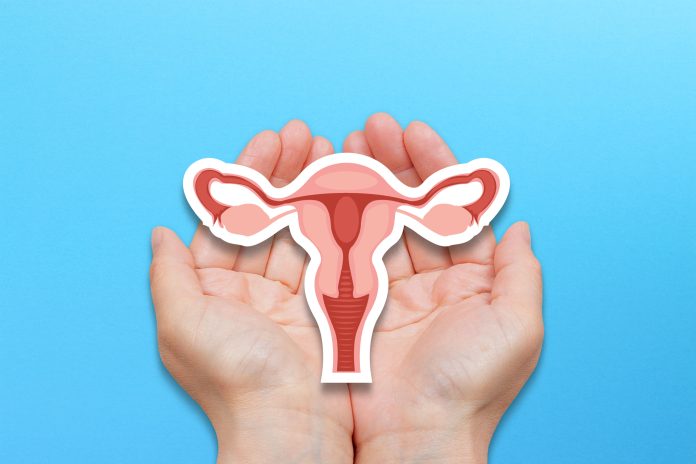Despite its prevalence and impact, PCOS remains an under-recognized, under-diagnosed, and under-funded condition. Sasha Ottey and Katherine Sherif explain why this approach to the condition must change
Polycystic Ovary Syndrome (PCOS) is defined as a cluster of symptoms, including irregular menstrual intervals, hyperandrogenism (symptoms: hirsutism, alopecia, cystic acne, or elevated serum androgen levels), and polycystic ovaries. Not all women and girls have all symptoms or even polycystic ovaries, but most have irregular menstrual intervals (outside 25-35 days). Insulin resistance is also a key feature of PCOS but is not included in the most commonly relied-upon definitions. The prevalence of PCOS is higher than diabetes – as high as 15% – yet diabetes is considered an epidemic, while PCOS largely remains underrecognized. (1, 2)
PCOS risk factors
The etiology of PCOS is unknown, but there are known genetic associations. (3) Prevailing theories include a) hypothalamic signaling favoring ovarian androgen formation and b) insulin resistance triggering ovarian androgen excess. Women with PCOS also have been shown to have a distinct intestinal microbiome. (4)
As our understanding of gut dysbiosis evolves, the role of inflammation in the development of PCOS will become clearer. Risk factors include first-degree family members with PCOS.
Challenges in PCOS diagnosis and care
PCOS is significantly underdiagnosed due to several factors. (5) Diagnosis is often hampered by:
- A low threshold and over-reliance on prescribing hormonal contraception to young women for menstrual issues before establishing a diagnosis;
- Lack of education among all physicians;
- Silos in medicine and the artificial division between gynecologic medicine and all other areas of medicine;
- A lack of awareness about PCOS by the general public;
- Lack of and declining funded research on conditions that primarily affect women and girls; and
- Inaccuracy of sex hormone assays. (6)
The paucity of both education and research has resulted in the continuing under-diagnosis and suboptimal treatment of PCOS. The high prevalence of associated conditions such as obstetric complications, liver disease, and chronic pelvic pain persists due to a lack of knowledge about the interconnection between sex hormones and inflammation. (7, 8, 9) Historically, PCOS research focused mainly on the reproductive aspects of PCOS, causing knowledge gaps in non-reproductive aspects of the syndrome. Early treatment could prevent metabolic and obstetric health issues. Instead, reliance on hormonal contraception masks the underlying metabolic problems. It prevents the early diagnosis of PCOS, leading to the development of cardiometabolic problems when women and girls decide to stop using hormonal contraception.
Physical and mental impact of PCOS
PCOS has a significant impact on quality of life and long-term health. Symptoms such as hirsutism, alopecia, elevated body weight, cystic acne, pelvic pain, mental health and mood disorders, and hidradenitis suppurativa erode the quality of life, especially in a medical model that does not validate or support the lived experience of women and girls with PCOS. For example, hirsutism, which can be diagnosed in 65-75% of patients with PCOS and is most commonly caused by PCOS, can have a profound impact on body image, mental health, and quality of life and is associated with higher rates of hospitalizations and longer hospital stays. (10) Most hair removal options are not covered by insurance in the U.S., considering it cosmetic rather than a medical condition.
Long-term health is affected by hyperandrogenemia, which promotes inflammation and insulin resistance. Inflammation and insulin resistance lead to impaired carbohydrate metabolism, leading to type 2 diabetes, gestational diabetes, and fatty liver. (11) Inflammation underlies mood disorders and accelerates aging and the risk for cognitive impairment and endometrial carcinoma. (12) Epidemiologic studies of PCOS have found an association with PCOS and a higher prevalence of all metabolic conditions and several cardiovascular conditions, including coronary artery disease, heart attack, arrhythmia, and stroke. (13)
The need for further research
The priorities for improving care for people living with PCOS are centered on education and research. Education requires a shift in the mindset that reproductive medicine is separate from all other spheres of medicine. The paradigm has allowed the marginalization of health problems that affect women. PCOS is, in fact, a paradigm of a women’s health issue in that sex hormone effects are inseparable from metabolic abnormalities. The same shift needs to occur in federally funded research. NICHD is recognized as the lead institute on PCOS and has historically funded up to 70% of PCOS research, significantly increasing understanding of the disorder. However, as one of the lesser-funded institutes with a predominant focus on reproductive health, its capacity to fully explore the disorder’s broader spectrum—including metabolic, cardiovascular, mental health, and other significant health manifestations—is limited. (14)
This limitation underscores the necessity for support and interdisciplinary collaboration across multiple NIH institutes that specialize in these areas to manage these issues effectively. Such collaboration is crucial for reducing the economic burden of the disorder and improving health outcomes and quality of life for those affected. The annual economic burden of PCOS in the United States exceeds $15bn, yet the estimated NIH allocation for PCOS research in 2024 is only $10mn. (15, 16) This stark contrast highlights a critical gap in funding and focus that does not match the disorder’s widespread impact and complexity. Research and education policy need to prioritize PCOS, which affects as many as 15% of women and girls and remains largely neglected by both clinicians and the research community, especially compared to the scale and impact of the condition.
References
- Legro RS, Arslanian SA, Ehrmann DA, et al. Diagnosis and treatment of polycystic ovary syndrome: an Endocrine Society clinical practice guideline [published correction appears in J Clin Endocrinol Metab. 2021 May 13;106(6):e2462]. J Clin Endocrinol Metab. 2013;98(12):4565-4592. doi:https://doi.org/10.1210/jc.2013-2350
- Teede HJ, Tay CT, Laven J, et al. Recommendations from the 2023 International Evidence-based Guideline for the Assessment and Management of Polycystic Ovary Syndrome. Fertil Steril. 2023;120(4):767-793. doi:https://doi.org/10.1016/j.fertnstert.2023.07.025
- Dapas M, Dunaif A. Deconstructing a Syndrome: Genomic Insights Into PCOS Causal Mechanisms and Classification, Endocrine Reviews, Volume 43, Issue 6, December 2022, Pages 927–965, https://doi.org/10.1210/endrev/bnac001
- Guo Y, Qi Y, Yang X, Zhao L, Wen S, Liu Y, et al. (2016) Association between Polycystic Ovary Syndrome and Gut Microbiota. PLoS ONE 11(4): e0153196. https://doi.org/10.1371/journal.pone.0153196
- Sherif K, Coborn J, Hoovler A, Gill L. Medical journey of patients with polycystic ovary syndrome and obesity: a cross-sectional survey of patients and primary care physicians. Postgrad Med. 2022 Nov 12:1-9. doi: https://doi.org/10.1080/00325481.2022.214051
- Cree, MG, Ottey S, Sherif K, Sugahara O, Pokuah F, Lyle AN, Vesper HW. Comparison of LC-MS/MS Testosterone Assays Towards Standardization of Lower Testosterone Ranges. 86th Annual Meeting of the Endocrine Society, Chicago, June 2023.
- Qin JZ, Pang LH, Li MJ, Fan XJ, Huang RD, Chen HY. Obstetric complications in women with polycystic ovary syndrome: a systematic review and meta- analysis. Reprod Biol Endocrinol. 2013;11:56. doi:https://doi.org/10.1186/1477-7827-11-56
- Singh V, Mahra K, Jung D, Shin JH. Gut Microbes in Polycystic Ovary Syndrome and Associated Comorbidities; Type 2 Diabetes, Non-Alcoholic Fatty Liver Disease (NAFLD), Cardiovascular Disease (CVD), and the Potential of Microbial Therapeutics. Probiotics Antimicrob Proteins. Published online April 22, 2024. doi:https://doi.org/10.1007/s12602-024-10262-y
- Cherlin T, Ottey S, Mohammed S, Sherif K, Verma S. Pain in PCOS – manuscript in preparation 2024.
- Kim AB, Cheng BT, Hassan S. Hirsutism is associated with increased hospitalization for mental health disorders. Arch Dermatol Res. 2023 Jul;315(5):1277-1286. Doi: https://doi.org/10.1007/s00403-022-02477-2. Epub 2022 Dec 19. PMID: 36534356.
- Zhao H, Zhang J, Cheng X, Nie X, He B. Insulin resistance in polycystic ovary syndrome across various tissues: an updated review of pathogenesis, evaluation, and treatment. J Ovarian Res. 2023;16(1):9. Published 2023 Jan 11. doi:https://doi.org/10.1186/s13048-022-01091-0
- Huddleston HG, Jaswa EG, Casaletto KB, et al. Associations of Polycystic Ovary Syndrome With Indicators of Brain Health at Midlife in the CARDIA Cohort. Neurology. 2024;102(4):e208104. doi:https://doi.org/10.1212/WNL.0000000000208104
- Wang Z, Jukic AMZ, Baird DD, Wilcox AJ, Li H, Curry CL, Fischer-Colbrie T, Onnela JP, Williams MA, Hauser R, Coull BA, Mahalingaiah S. Irregular Cycles, Ovulatory Disorders, and Cardiometabolic Conditions in a US-Based Digital Cohort. JAMA Netw Open. 2024 May 1;7(5):e249657. doi: https://doi.org/10.1001/jamanetworkopen.2024.9657. PMID: 38700861.
- Brakta, S., Lizneva, D., Mykhalchenko, K., Imam, A., Walker, W., Diamond, M. P., & Azziz, R. (2017). Perspectives on Polycystic Ovary Syndrome: Is Polycystic Ovary Syndrome Research Underfunded? The Journal of clinical endocrinology and metabolism, 102(12), 4421–4427. https://doi.org/10.1210/jc.2017-01415
- Surabhi Yadav, Olivia Delau, Adam J Bonner, Daniela Markovic, William Patterson, Sasha Ottey, Richard P Buyalos, Ricardo Azziz (2023) Direct economic burden of mental health disorders associated with polycystic ovary syndrome: Systematic review and meta-analysis eLife 12:e85338. https://doi.org/10.7554/eLife.85338
16. National Institutes of Health (NIH). (2023, March 31). Estimates of Funding for Various Research, Condition, and Disease Categories (RCDC). RePORT.











